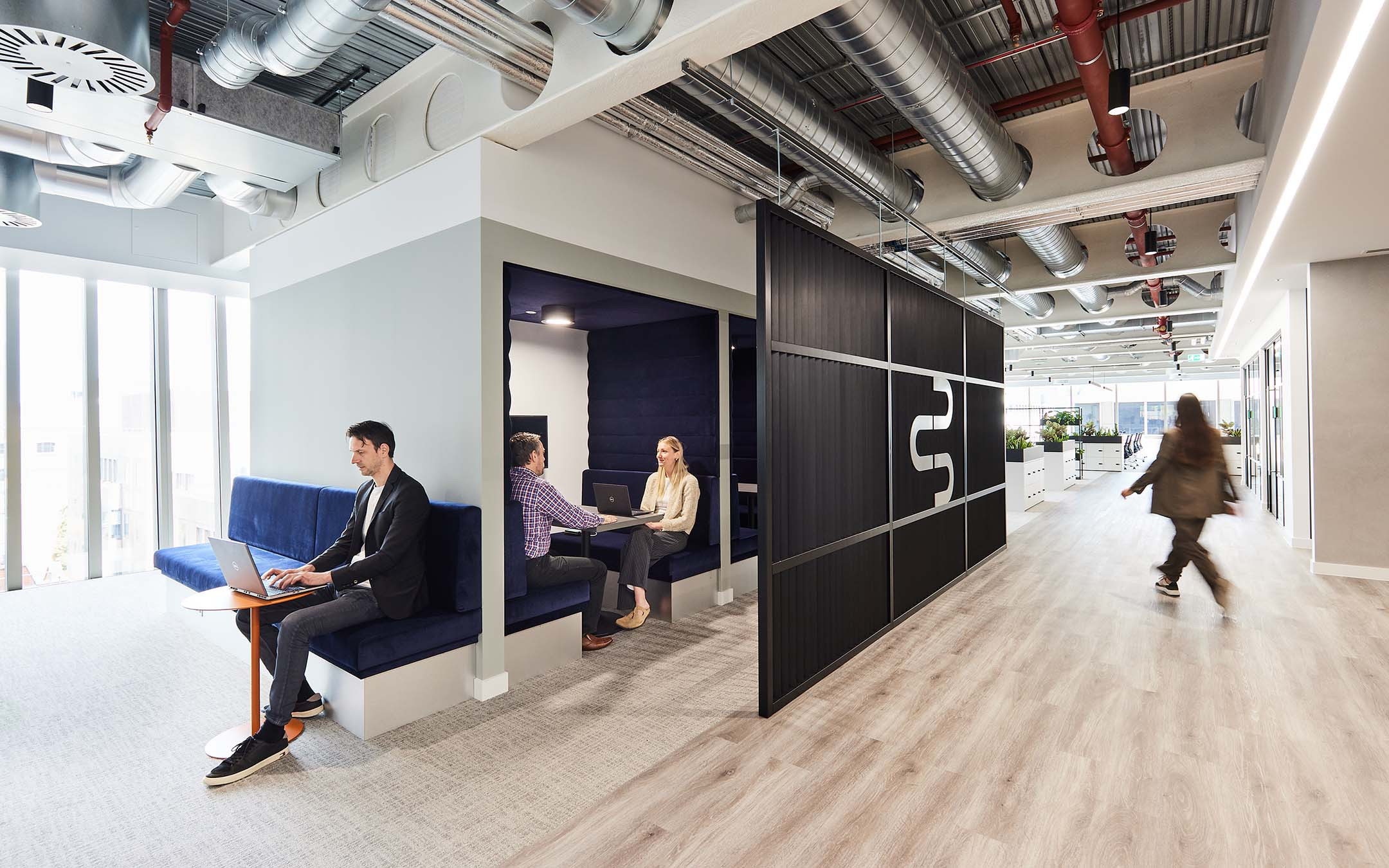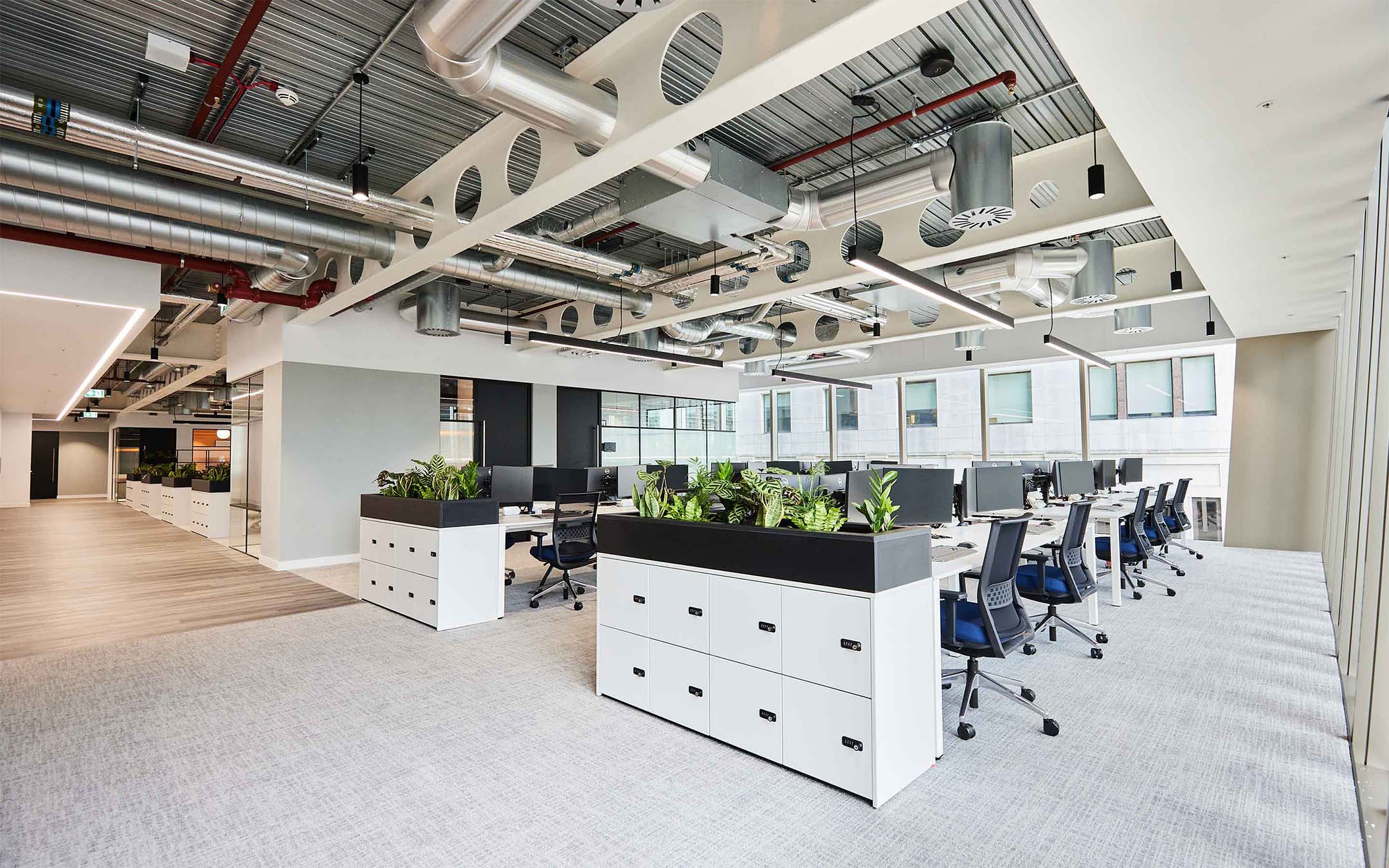Open-plan offices - a space for all
As agile or smart working is rolled out across more and more businesses, Steve Taylor, Project Director, looks at the essential role the open plan office plays in helping businesses evolve and implement new ways of working.


Offices have come a long way from the days of isolated cubicles and brief chats at the water cooler. Today, many businesses understand how much the layout and design of their workspaces matter. A well-designed office not only boosts collaboration and comfort but also creates an environment where employees enjoy spending their time.
One of the biggest trends in office design is the open-plan layout. An open-plan office is a large workspace where employees share the same area instead of working in separate rooms or cubicles. But, while some people thrive in open-plan spaces, others may find this challenging.
Despite its intentions of communication, open-plan offices don’t always have the best reputation. Distractions from noise, a lack of privacy, and difficulty focusing are common complaints. But are these criticisms justified?
Many of these problems can be solved with smart design choices. By adding private areas and quiet spaces, an open-plan office can still be social and collaborative while giving people the privacy they need. When done right, an open-plan office can be an exciting, motivating place where people enjoy coming to work.
Challenges of open-plan offices
With so many people in one space, background conversations, phone calls, and general office buzz can make it difficult to concentrate. While others might enjoy the bustling nature of a busy office, other employees might struggle with the layers of noise when trying to focus.
Another consideration is lack of privacy. In an open-plan office, it can often be hard to find a private spot for sensitive conversations or focused work without walls or enclosed areas.
Constant interruptions from colleagues can further disrupt workflow, making it tough to stay on task. This surrounding activity can lead to heightened stress and anxiety for some people, which stresses the importance of finding a balance between collaboration and the need for personal space in the workplace.
Advantages of open-plan offices
Open-plan offices offer numerous advantages that improve collaboration and encourage a sense of community. With fewer physical barriers, communication becomes more fluid, allowing team members to share ideas and work together on projects without needing to get up and out of their desk or spend time typing out a lengthy email. This layout not only encourages teamwork but also helps to strengthen relationships among colleagues, creating a more cohesive work environment.
Beyond the interpersonal benefits, open offices are typically more cost-effective to design and maintain, utilising less space and needing fewer materials like walls and doors. This means the environment is more adaptable and allows businesses to rearrange furniture or create temporary workspaces to meet evolving needs. Plus, the absence of walls allows an even distribution of natural light throughout the space, meaning a brighter and more inviting workplace.
How to ensure quiet spaces
With so many benefits to an open-plan office space, businesses should consider how they can implement this while also providing a balance between socialisation and privacy. With an effective workplace strategy, employers can create a space that is communicative and comfortable, while also providing dedicated spaces for focus time or private meetings.
1. Create designated quiet zones
Set aside specific areas in the office where noise is kept to a minimum, allowing employees to focus without distractions. These zones can be separate rooms or quiet corners with comfortable seating and minimal interruptions. Ensure there are enclosed rooms available for confidential conversations, such as meetings or phone calls, where sensitive information can be discussed without being overheard.
2. Acoustic solutions
Businesses can make their offices much more comfortable and productive by adding smart acoustic solutions in the workplace. Loud, noisy environments can be really distracting, especially when employees are trying to focus. Good acoustics, like soundproof rooms or panels, help keep noise under control so people can concentrate better. In fact, research shows that about half of office workers feel noise makes it hard to get their work done.
Acoustic solutions like quiet pods, panels, and even creative touches like repurposed materials or plants can reduce noise and create private spaces for meetings.
3. Use phone booths or privacy pods
Phone booths are taking the corporate world by storm. These small, enclosed spaces that can be placed almost anywhere in an office allow employees to make private phone calls or work on confidential tasks without disrupting the open area, or having to search for an empty meeting room somewhere else in the building.
5. Provide noise-cancelling headphones
Another useful method is to encourage employees to use noise-cancelling headphones when they need to concentrate or tune out distractions.
Activity-based-working
An office should be a place that we can all come together in - a place to socialise, work, collaborate, play, study, produce and create in. Open plan offices, like all offices, must be places that encourage and attract people into them, but of course, not all do.
A badly designed open plan office is just a tyranny of desks, a space overly occupied with seating, storage units and photocopiers. This kind of environment, which prevents positive human interaction, will absolutely promote a heavier reliance of communication by emails and instant messages among employees. A badly designed open plan office does not help to build an organisation with a shared purpose, it can in fact decrease the wellbeing of employees, reduce productivity and diminish shared pride in the business.
Offices for people, not machines
Offices are for people, not machines and desks, and the key for a productive and happy office for employees is good workplace design. An open plan office designed around the philosophy of "Activity Based Working", which focuses on supporting every activity employees want and need to undertake to the highest standard, will generate a greater sense of harmony within the office and actively promote positive behaviours such as collaboration, focused working, socialising, community sharing and a sense of purpose.
With clever use of furniture, open plan offices can have different working zones, breakout areas and quiet areas to give employees a variety of spaces to work in. Furniture can also help to create a more homely and welcoming space. A large communal area such as a kitchen or tea points with work areas will help to bring people together physically and to socialise.
Due to their layout, open plan offices often have more natural light, which good design will enhance with plants and greenery -all important for employees’ wellbeing.
However, even with the best designed open plan office businesses still need to consider where teams and people are placed to enable them to work most productively. For example, it’s not a good idea to put the finance team who may like a predominately quiet work environment next to the noisy sales team. Privacy also must be considered, with quiet, acoustic and soundproof rooms an essential accompaniment for many businesses alongside open plan spaces.
A workplace for everyone
Businesses are increasingly realising the need to respond to different office personalities within their workforce, and there is greater understanding that a badly designed office will affect employee morale and productivity. We have seen an increasing uptake of workplace consultancy and a shift towards more data-driven, fact-based design based around the individual and business needs of the company.
Companies are more willing to consult with their employees about what they need and want, and to act on what they hear. There is a greater consideration for mental health and wellbeing which is reflected in the focus on getting the right acoustics, light, biophilic design and social and communal areas. Through a process of Change Management, companies can ensure people are at the heart of the project as it moves along, and when they move in to their new office space, this will help improve how quickly and effectively they adapt and flourish.
Fostering social interaction
Offices are places for people, and their design should reflect that. Workplaces should foster social interaction and engagement, encourage creativity and nurture as sense of belonging to a team. Creativity leads to fresh thinking and a sense of team-belonging can positively impact staff retention – all of which is positive for the employer.
Establishing a social design is relatively simple. Alongside traditional work stations, business should adopt informal community and collaborative spaces such as soft seating areas, coffee bars and even space capsules that allow staff to integrate away from their desks. Creating ‘collision points’ such as centralising the printer, water fountain, coffee machine and recycling bins can foster more spontaneous social interactions.
Whatever your experience has been with open plan offices, there are plenty of success stories of where it has been done well and people and businesses have flourished. Our design for Dale Underwriting Partners was all about creating exceptional business through promoting culture and collaboration for their people, using interior design and open-plan layouts. Check out the space.


In summary
- The role of open-plan offices
- Open-plan offices are increasingly popular as businesses embrace agile and smart working practices.
- They encourage collaboration and communication by eliminating physical barriers between employees.
- Challenges of open-plan offices
- Common issues include noise, distractions, lack of privacy, and difficulty concentrating for some employees.
- These challenges can lead to stress and decreased productivity if not properly managed.
- Advantages of open-plan offices
- Open spaces promote teamwork, encourage stronger relationships, and create a sense of community.
- Cost-effective and adaptable, open-plan offices also allow for better use of natural light and space.
- Solutions for quiet spaces
- Implement designated quiet zones, phone booths, and acoustic solutions like panels to balance socialisation with focus.
- Providing noise-cancelling headphones can help employees reduce distractions.
- Activity-based working
- Designing open offices around different tasks (e.g., collaboration, focused work, socialising) creates a flexible, supportive environment.
- Using varied furniture and creating specific zones for different activities fosters harmony and productivity.
- Fostering social interaction
- Social areas, like coffee bars or communal spaces, can encourage interaction and build a sense of belonging.
- Strategic office design can enhance creativity, boost employee retention, and improve overall workplace happiness.

Start your workplace transformation today.
Your workplace holds enormous potential to improve your business performance. Get in touch today, and we will unlock that potential together.

